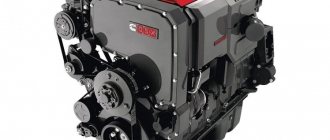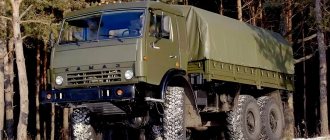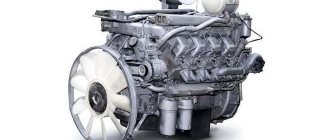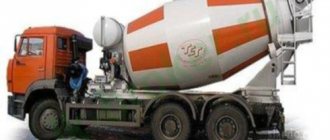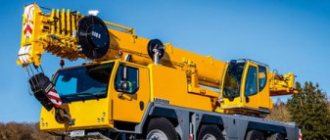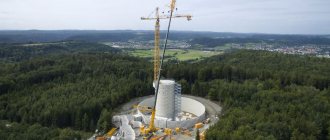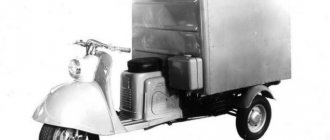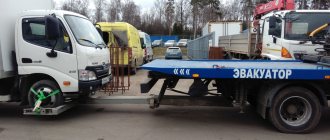load on the rear axle (trolley);
water tank capacity.
The modern ABS model range includes nine types of machines with drum volumes of 4,5,6,...,11,12 cubic meters.
Vehicles capable of holding up to 15 cubic meters of concrete are produced to order, but ordinary buyers mainly purchase concrete mixer trucks with drum volumes of 5.7 and 9 cubic meters.
Many different modifications are applicable to the main ABS model range. The changes relate to the hydraulic transmission and the installation of water tanks of different capacities.
It is possible to change the mixing drums and the concrete mixer control system, as well as improve the autonomous motors and water supply.
The most popular Russian brands are considered:
Most often, a concrete mixer truck is placed on the KamAZ-6520 base, the technical characteristics of which are suitable for this installation.
Foreign cars:
Additional functions
Most truck-mounted concrete mixers have a function that allows you to weigh and dose the ingredients of the building mixture. Thanks to this, the final result is a composition that is ideally suited in terms of its characteristics to a particular customer.
In addition, special equipment that automatically regulates the composition of the concrete solution allows the use of a concrete mixer truck for better road construction and repair.
The weighing system of some ABS contains a load cell built into the hydraulic system of the drum. It weighs the concrete components as they enter the cavity, and as soon as the required volume of materials is reached, an audible alert sounds.
In more expensive automatic concrete mixers, several strain gauges are installed, which make it possible not only to determine the mass of all components of the building mixture, but also to regulate their quantity during mixing.
terms of Use
In order for the concrete mixer truck to always perform its job efficiently, it is necessary to follow several operating principles.
If you do not perform at least the basic ones, the operation of the concrete mixer may be disrupted, the concrete solution will be prepared incorrectly, and the machine itself may fail.
- It is necessary to ensure that the turns of the drum do not overlap each other, but wind smoothly and clearly during operation.
- ABS parts should not get too hot.
- It is necessary to periodically lubricate the parts of the concrete mixer that rub against each other . Each model is lubricated differently, and you should read about this process in the owner's manual.
- During the cold season, water should not remain in the dosing system .
- After completion of the work , the pit into which the skip lift bucket is lowered must be thoroughly cleaned . It is necessary to remove all remnants of building material and only then lower the bucket into place.
- It is necessary to control the dosing and unloading mechanism , monitor the quality and quantity of incoming and outgoing materials.
- It should not be allowed that some of the materials are already in the drum, and the other has not yet been delivered to the loading site of the device.
- If there is any suspicion of a problem with the operation of the concrete mixer, it is necessary to stop the system , find the problem and fix it, and only then continue to operate the mixer.
Concrete mixture or water must not be allowed to leak , so keep the discharge hole and tank tightly closed.
You should not try to fix the breakdown yourself without having the proper technical skills.
You can read about the technical characteristics of the Kuzbass sowing complex here. You will also learn about additional capabilities of this technology.
Under no circumstances should you fix the problem while the mechanism is on!
If you follow these simple operating rules, your concrete mixer can last a long time. At the same time, the finished material will retain excellent parameters, and the process of mixing the components will proceed without failure.
We offer you to watch a video example of the operation of a concrete mixer truck based on KamAZ, the technical characteristics of which are similar to the parameters discussed above:
If you find an error, please select a piece of text and press Ctrl+Enter.
KamAZ concrete mixer trucks
Concrete mixer trucks, made on the KamAZ basis, are used to transport concrete mixture from the manufacturer to the construction site. By using such a machine, the mortar is also moved along the entire perimeter of the construction site. Thanks to constant rotation, the concrete mixture inside the mixer is maintained in a liquid state. The KamAZ automobile concrete mixer prevents the homogeneity of the solution from being disrupted and does not allow the mixture to be lost during transportation, loading and unloading.
Principle of operation
The operating principle of this technique is quite simple. It consists of alternately closing and opening valves through which the mixture passes. A piston is used to push it out. When it moves, the concrete ends up in a special hole.
While inside the mixer, the solution is constantly mixed. This happens until the mass is used for its intended purpose.
Concrete supply using a pump Source specteh-crimea.speczakaz.info
Device
The design features of an automobile concrete mixer are determined by the need to prevent precipitation from entering the finished concrete mixture. The safety and uniformity of concrete is achieved by rotating the drum during movement.
The mixing drum is installed on the KamAZ chassis at an angle of 10 degrees. Special spiral blades are installed inside it. When they rotate in the opposite direction, the concrete mixture is unloaded. Concrete flows out of the container through installed gutters. One of them is installed directly in the concrete mixer, and the second is pulled to the machine at the unloading site. Special pumps can also be used for these purposes.
Characteristics and design features of concrete mixer trucks
A concrete mixer truck is a type of specialized equipment designed for preparing and transporting liquid construction mixture. The main goal of ABS is the prompt delivery of the solution to the place of requirement.
Other functions of concrete mixer trucks:
- Preparation of concrete solution (from components loaded into a container) in the process of moving to the construction site.
- Mixing concrete mixture directly on site.
An important structural element of a concrete mixer is a rotating tank mounted on a truck chassis, with spiral blades fixed inside the tank. When loading the solution, the blades push it inside the tank; when unloading, they push the mixture out. While the vehicle is moving, the drum always rotates, maintaining the concrete mixture in a usable condition.
The tank volume of concrete mixer trucks can range from 2 to 15 m3. The most popular equipment is with a capacity of 7 m3. For example: Dieci F 7000, Man TGA 33.480 B, Scania R480, Volvo FM 370, Renault Kerax 370 DCI, Iveco 260, Scania P114.380, Mercedes-Benz Arocs 3243 B, Euromix EM 7 R, Ford 3542.
Concrete mixer trucks, depending on the method of preparing the mixture, have different types of drums:
- Gravity, which has fixed blades. When the drum rotates, the building mixture flows down under the influence of gravity.
- Forced action drum. Has rotating blades. It is used in more powerful concrete mixer trucks, in concrete plants, and in concrete units. The resulting mixture is homogeneous and of high quality.
There are also mixers with concrete mixer designs with concrete pumps. For example: Scania 143 8×4 Full Steel, Man TGS 32.440, Renault Kerax 370 DCI, Mercedes-Benz Arocs 3243 B. The equipment is used in the construction of bridges, tunnels, and high-rise buildings. The solution supply height is up to 25-30 meters.
The lineup
The model line includes variations of vehicles that use various models of KamAZ trucks as a basis. This point largely determines the operational potential of the vehicle.
KamAZ 581453
The three-axle concrete mixer has a 6x4 wheel arrangement. The truck is equipped with a hydromechanical drive and a reliable power plant made in Germany. The planetary gearbox was manufactured in Italy. The main functional elements subject to the greatest wear are made using high-strength steel. This moment ensures the overall maximum service life of the machine. The model is designed for use throughout the year. This becomes possible due to the fact that the chassis engine heats the liquid in the water tank with exhaust gases.
Technical characteristics of the KamAZ 581453 concrete mixer:
Construction of a concrete mixer truck through the eyes of an amateur: interesting details
The general design of a concrete mixer truck can differ radically from each other. Have different technical characteristics, parameters by which they are qualified. The main task remains common - delivering concrete to construction sites, sometimes significantly distant from concrete plants.
The construction of houses and cottages in agricultural areas, road repairs and new construction of highways require large “infusions of concrete”. Installations and structures that transport concrete in accordance with the strict GOST rules must meet certain criteria.
Popular models of concrete mixers
A concrete mixer vehicle may be required for the construction of almost any structure of significant scale. Today there are a large number of such vehicles, differing from each other in functionality, volume and technical characteristics. Below are some of the most popular models.
Concrete mixer truck 58149Y on KAMAZ-6540 chassis
The manufacturer of this model is the Taymuzinsky concrete truck plant. The maximum weight of material transported by this vehicle is limited to 16,800 kilograms. The ABS mixing drum drive is powered by an independent motor. The water tank has a volume of 600 liters. The car uses an 8x4 wheel arrangement.
The main technical characteristics of the model are as follows:
- total weight: 31100 kilograms;
- loading height: 3750 millimeters;
- curb weight: 13525 kilograms;
- mixing drum capacity: 9 cubic meters.
Cars of this type use Cummins ISB6.7e4 300/ ISB6.7 300 engines with power up to 307 hp. With. The environmental class of these devices meets EURO-4 requirements.
Concrete mixer truck Man 35.322
Among vehicles for preparing concrete, the TC Man 35.322 is in particular demand. This German-made machine allows you to transport a solution with a volume of up to 10 cubic meters.
The main technical characteristics of the model are as follows:
- total weight: 35,000 kilograms;
- mixing drum capacity: 10 cubic meters.
The presented concrete mixer is equipped with a 9973 cc engine. This device is capable of developing power up to 322 hp. With. The car uses an 8x4 wheel arrangement.
Interestingly, the concrete mixer or mixer for construction work is equipped with a mechanical ZF automatic gearbox. The vehicle allows you to transport ready-made cement mixture or prepare it directly on the road. The relatively small overall dimensions of the vehicle allow it to maneuver quite freely within populated areas or on construction sites.
Classification criteria for concrete mixer trucks
From the GOST requirements for delivering concrete to its destination, the following can be identified as fundamental: to exclude the penetration of precipitation into the concrete mixture: it must remain homogeneous (homogeneous), direct sunlight does not touch the surface of the solution, minimal losses during loading, transportation, unloading.
And one more diagram.
Car modification
Installing a concrete mixing plant on a car and giving it new functions and properties was forced by life at the beginning of the 20th century, when construction grew into an industry. Delivering freshly mixed concrete in an open, metal car body was no easy feat.
Cities, dams, factories were built, and a lot of building materials were required, including concrete. It splashed over the edge on potholes in the roads, got wet in the rain, froze in frosts, and dried out under the scorching rays of the sun without protection. The first experiments in delivering concrete mortar in special barrels mounted on a car took place in the mid-30s.
If in the 70s there was a shortage of this equipment because only 2 mechanical factories in the USSR were producing, then by the end of the 20th century, the auto concrete mixer organically fit into the production processes of modern construction.
Attention: Equipment for obtaining and transporting concrete mortar can be mounted on a truck chassis of the appropriate load capacity. In Russia, the most common concrete mixers are KamAZ 6520.
Automotive giants such as Ural, MAZ, KrAZ and KamAZ produce chassis for concrete installations. Foreign partners have always represented serious competition to domestic automakers, so there is no shortage of these installations now.
Types of modifications
Having heard the simple phrase 90 x 60 x 90, every adult understands that we are talking about the parameters of a beautiful female figure. Concrete mixer trucks have their own technical characteristics.
Manufacturers of these structures strive to improve them, so there are various modifications in the design of concrete mixers, and the criteria by which they are qualified:
- The machine was manufactured at the Pushkin Mechanical Repair Plant. Basic chassis from Hyundai HD 370, licensed by SCHWING – STETTER.
- The drum capacity is 9 m³, these designs accumulate modern technological innovations in this area;
- A concrete mixer car with an autonomous engine continues to work if the car fails. This indicator characterizes the concrete mixer as a reliable installation, but the car itself has an impressive weight.
Installed on the chassis. The engine on the chassis has a low noise level and is lighter in weight. Concrete mixers, however, look somewhat unusual.
Rear view of the cabin.
- A concrete mixer truck equipped with an engine on a chassis uses fuel economically and emits less harmful substances into the atmosphere.
- Drum drive type
The drive of the mixing drum was previously mechanical, but there are fewer and fewer such machines left.
- The hydraulic drive, which has a smooth ride and a more advanced design, squeezes out mechanics and rightfully occupies its niche.
- Unloading method
- The first unloading method is the most common. It allows you to approach the unloading object as close as possible and deliver the solution more accurately.
- The second “forward” unloading method is attractive because the driver controls the process from the cab.
- One of the main characteristics of the machine is the size of the mixing drum. The capacity ranges from the smallest of 2 m³ to the largest of 12 m³. The installation price changes accordingly, which is influenced by the cost of the chassis and the manufacturer.
Types of concrete mixers
Models of auto mixers are distinguished by several parameters.
Machine classification
ABS with conveyor belt.
- Type of working motor. The engine can be stand-alone or mounted on a chassis. The first type makes it possible to mix concrete even if the vehicle itself breaks down. Based on this, experts consider an autonomous motor to be the most reliable. Engines mounted on the chassis are lighter and more environmentally friendly; they make little noise.
- Mixer tank drive. Previously, ABS was equipped with its mechanical type. Now modern technologies make it possible to install a hydraulic drive on the unit.
- The unloading method can be rear or front. The first method is more common, because it makes it possible to approach the unloading point closer and deliver concrete accurately. Front unloading gives the driver the opportunity to control the process directly from the vehicle’s cab.
- The drum size is one of the main characteristics of the machine. The smallest is a 2 m3 concrete mixer truck. The standard largest volume of the mixer is 12 cubic meters.
Machine characteristics
An example of ABS technical characteristics.
The technical characteristics of the concrete mixer truck take into account the following indicators.
- The maximum volume of solution that can be loaded into the drum.
- Maximum weight of concrete (with fully filled water tank).
- Weight of the equipped mixing device. The load on the rear and front axles or axles is also taken into account here.
- Total weight of the vehicle and all special devices.
- Water tank volume.
As already mentioned, the model line of mixers represents 10 types of ABS, equipped with 2/12 cubic meter drums. To order, you can purchase the largest concrete mixer truck, which is capable of transporting 15 cubic meters of solution at a time. However, the price of such a machine is quite high.
Note! Many modifications can be applied to standard models of auto-mixers. They may concern hydraulic transmission, installation of water tanks of different volumes, and mixing drums. Changes can improve ABS control, autonomous engine, and water supply.
The most common brands of mixers
Mixer based on KamAZ.
Mixing and additional equipment can be installed on the chassis of a Russian or foreign-made vehicle.
The highest quality and most popular domestic models of mixers are assembled on the basis of the following brands of machines:
Most often, ABS is assembled on the KamAZ/6520 chassis, since its technical characteristics are optimal for installing equipment.
The most popular models of foreign mixers:
- MAN;
- Ford;
- Volvo;
- Mercedes-Benz;
- Scania
- Iveco;
- Renault.
How to reduce concrete work time
Late delivery of concrete solution, partial short deliveries or, on the contrary, excess of it, who is not irritated by these “inconsistencies”.
In order to correctly calculate the needs for the required amount of concrete mixture, to properly prepare the unloading of the solution, you need to have a basic understanding of the design of special equipment, which includes truck-mounted concrete mixers, automixers, ABS and many other types of construction equipment.
- In the first option, the components, dry components from which concrete is made, are loaded directly at the plant, filled with water and slowly sent to the site. During the journey, the mixture is mixed until ready and maintained in the desired consistency, convenient for unloading;
- In the second case, the concrete mixer truck is loaded with ready-made mortar. The concrete mixer delivers liquid concrete to the transportation site;
Attention: Keeping the concrete mixture in a homogeneous state is ensured by constant mixing. This is a mandatory condition for transportation.
- The photo clearly shows the spiral blades inside the mixing drum;
- The Archimedes screw works flawlessly in this design. It rotates in one direction and a concrete mass is obtained; if you turn the blades in the opposite direction, you can take ready-made concrete;
- Receiving the concrete mixture from the concrete mixer truck under pressure allows it to flow down the tray directly to the work site;
- When it is not possible for a machine to drive close to the work site, workers extend chutes to concrete mixer trucks or use special devices in the form of booms and hoses. The simplest DIY device for draining concrete is a wooden gutter.
- Ordering a special ABS, which allows you to conveniently accept concrete from a distance of 10 m, is possible only if such equipment is available. This must be clarified and agreed upon with the operator in advance;
- It is necessary to take care of the site for the ABS in advance so that it does not stand idle for precious time;
- The minimum dimensions of the site are 6 x 8 m, the distance to the edge of the pit is at least 8 m, the slope is no more than 5%;
Attention: There should not be a power line running near the unloading site, there should be free space for deploying the unloading device and space for flushing the ABS.
If everything is thought out and prepared at a high professional level, the pipe for the concrete mixer truck is waiting in the wings and lies aside, then the concrete work can be completed quite quickly.
Caring owner of equipment
“In this weather, a good owner will not throw his dog out into the street,” it is clear that we are talking about a caring person. A good attitude towards anything, including technology, is evident from its condition. The video in this article talks about the operating principle of a concrete mixer truck.
Components, blocks and simply parts of this special equipment are constantly exposed to loads, which means mechanical wear. If the driver must maintain order, clean instruments in the cabin and regularly wash the outside of the car, then the repair of concrete mixer trucks should be entrusted to qualified specialists.
It is better to avoid mechanical breakdowns of parts, and to identify the weak link during a technical inspection.
- The gearbox design of a concrete mixer truck can be planetary. It is intended for drives of concrete mixers of the SB-138B, 146MA, 146A series. Transformation and additional strengthening of the rotor torque of the mixing plant, which is so necessary for high-quality mixing of heavy concrete mixtures.
- Or chained. The main part of the chain gearbox is the chain, which serves to transmit rotation to the drum from the sprocket. Concrete mixer trucks from domestic and foreign manufacturers use drive chains PRL-44, 45-1300013568.
The operating manual for a concrete mixer truck takes up a hefty volume in paper format. You need to be clear about your actions. Repairs of concrete mixer trucks can be current or major.
- Routine maintenance is performed after 1200 operating hours. The mixing drum blades, bearing units, gears and seals are checked. Control mechanisms are checked, which include fuel supply processes, clutches, and gear reverse. The routine maintenance instructions require washing the bearing housing and gearboxes. Clean the rollers, bandage, and sprockets from dirt and dust before lubrication. The truck and engine are lubricated in accordance with the operating manual.
Attention: You can order spare parts for concrete mixer trucks, carry out diagnostics and identify faulty mechanisms at special stands.
- Major repairs of a concrete mixer truck are carried out after diagnostics and a complete technical examination of the mechanisms. In addition to the repair operations listed above, replacement of worn parts with complete disassembly of components and blocks, assembly, adjustment, and lubrication are added. After a major overhaul, the concrete mixer truck is tested again and painted.
It is almost impossible to tell everything about concrete mixer trucks. Technologies and processes of the modern construction industry are being improved, and the latest building materials are offered.
Concrete mixtures were, are and will be as long as people first destroy objects, and then rebuild and restore them. And the preparation and delivery of concrete continues to be carried out by mini factories on wheels.
ABS device
Mixer diagram.
All auto mixers are equipped with oblong shaped drums. This container is mounted on the car at an angle of 10/15°.
Machine design
- The uniformity and safety of the solution during its delivery is ensured by the rotation of the drum.
- There are spiral blades inside it.
- Rotating in one direction during loading and delivery, they drive the mixture deeper into the tank. When the blades are moved in a different direction (the “Archimedes screw” principle is applied), the concrete is unloaded.
Note! The design of the concrete mixer truck is such that the solution can be prepared in it. To do this, you need to load fillers, water and cement into the drum.
- When unloading, the solution is pushed out of the drum under pressure and flows down trays to the work site. There are two such devices: one is equipped with the mixer itself, the second is installed by workers at the construction site with their own hands.
If the vehicle is not an all-terrain vehicle, then the ABS often cannot approach the work site to the required distance. In this case, the trays cannot reach the unloading area. Then special devices are attached to the concrete mixer.
Solution supply
Mixer with extended tray.
The mixer can supply the solution to the construction site using the following devices:
- standard or extended tray for concrete;
- conveyor belt;
- pipes;
- concrete pump;
- PUMIK.
Extended trays are used when unloading factory solution for a length of up to 7 m. They are extended using hydraulics. The pipe can be connected to a standard ABS tray, 3 m long.
It can also extend the concrete delivery distance up to 7m.
- Conveyor belts look like a rubber track 0.4 m wide and 10/14 m long. They work on the conveyor principle.
- The instructions say that they are capable of delivering the mixture to a height of up to 4 m.
- Such a device can be rotated left/right at right angles.
The photo shows a diagram of how ABS works with a pump.
A concrete mixer truck with a concrete pump is equipped with a folding boom and can pump the solution horizontally and vertically. The length of the boom, depending on the mixer model, can reach 60 m. The length of concrete supply can be increased using additional hoses 5 m long. They can be installed up to 4 pieces. Unit productivity is up to 80 cubic meters per hour.
The conditions for successful operation of ABS with a pump are as follows.
- To install the device, you need a solid platform, based on the car depot model - from 9?12 m to 12?15 m.
- It is desirable that the construction site have water for technical flushing of the unit and a place for its drainage.
- You can interrupt the supply of the solution for no more than half an hour. At temperatures below -5 or above +25 degrees there should be no interruptions.
- The unit can supply concrete of a grade not lower than M-200 (class B-15), which has a plasticity of up to P-4.
PUMIK is a machine that combines a concrete mixer and a concrete pump. It can pump mixture to heights of up to 28 m, with a range of 24 m.
Note! To install the unit you do not need a spacious area. To operate the machine, you need dense soil and free space around it.
The history of mobile concrete mixers
Today, any construction project is practically impossible without such special equipment. It first appeared at the beginning of the last century in America. The first to be produced were mixers designed only for transporting ready-mixed concrete.
A little later, concrete mixers on wheels appeared, into which components were loaded, and the preparation of concrete took place directly on the road.
By its design, such equipment could not transport the ready-made mixture, and only in the mid-thirties in the USA was the production of universal mixers launched that could produce concrete and deliver the ready-made mixture. During this period, the first machines of this type were produced in the Soviet Union, but due to design flaws and poor workmanship, their production was discontinued.
Only in 1938 did specialists return to the development and production of this special equipment at two USSR factories at once. The cars turned out to be more successful, but had one drawback - low speed of movement. Their mass production in our country began in the 80s, when the production of mixers based on KamAZ began.
General information about automixers
Mixers currently produced help manufacturers meet stringent building standards for transporting concrete mixtures. They become especially cost-effective when servicing remote construction sites. The main functions of this special equipment are:
- Preparation of concrete during transportation, to the construction site from a special installation, where dry components are loaded into it.
- Loading and transportation of ready-made liquid concrete.
- Using it as a stationary concrete mixer already at a construction site.
The requirements for manufactured mixers these days are quite high. Thanks to the successful work of the design bureau, the latest models of concrete trucks are capable of transporting up to 12 m³ of construction material. The designs of concrete mixer trucks are distinguished by the type of drive of the mixing drum and the engine that drives it. They are:
- With an autonomous engine located on the platform of the car, which, with the help of a transfer gearbox and chain, causes the drum to rotate.
- The container rotates due to a hydromechanical transmission from the main engine of the truck.
Currently, special equipment is produced with the second type of drive, as it is considered more reliable and allows reducing the total weight of the mixer. The operating principle of a concrete mixer is quite simple. On the vehicle platform there is a pear-shaped container located at an angle of 10-15° relative to the horizontal plane.
Inside it there are blades based on the principle of an Archimedes screw. When rotating in one direction, the mixture is loaded and prepared, and in the other direction, the mixture is unloaded. The narrowed filler neck allows you to protect the concrete mixture from the effects of various natural phenomena.
Mixing drum
Drum volume based on the output of the finished mixture. The most important thing is to choose the volume of the drum based on the output of the finished mixture; this figure is less than the geometric capacity of the drum. The market offers ABS that can hold from 2 to 15 m3 of concrete mixture. In cities, mixers with a volume of 7 and 9 m3 are most popular; machines with 4 and 5 m3 are less common. Among foreign models, there are cars capable of preparing and transporting 6 m3 of solution.
Thus, Liebherr offers a wide range of premium ABS with capacities from 6 to 15.5 m3 on car and semi-trailer chassis. Upon request, ABS can be equipped with a conveyor belt.
But the fact is that 6 cc drums are mounted on the same chassis as 7 cc drums. As a result, the price of the cars is almost the same, and the difference in volume is noticeable. For the same reason, there is almost no demand for 8 m3 models - they are inferior to 9 cc versions. However, some experts recommend choosing large-volume ABS, about 11 m3, and not 7 m3, for example. This is justified by saving fuel and driver salary costs, as well as higher profits per cubic meter of solution transported. True, when using an 11-cc ABS, fines are possible for exceeding the axle load, and the driver must also be highly qualified and conscientious.
It is unprofitable for companies to maintain small-volume ABS, since even one-time deliveries, as a rule, are of larger volume. Market statistics confirm the same: due to lack of demand, companies are reducing the production of small-volume concrete mixers. Machines with a volume of less than 5 m3 are almost never produced in Russia; this segment is completely occupied by imported equipment. Most often these are used Japanese cars. In the western part of the country there are “Europeans” who, as a rule, are not new either. They have engines of low environmental class, and there is a greater risk of being fined. In addition, with the tightening of fines for exceeding the axle load under Federal Law No. 248-FZ since 2015, many factories have switched to delivery by incomplete vehicles, and only 2-3 m3 of concrete are delivered to a 5-cc ABS.
The exception is mod. “UNIMIX-4” is a self-propelled all-terrain chassis with a hydrostatic drive, a mixing unit with a capacity of 4 m3 on a slewing ring and a self-loading mechanism, produced by KOMZ-Export CJSC TIGARBO brand ) from Kamensk-Shakhtinsky, Rostov region. The installation allows you to autonomously produce concrete mixtures of various grades from cement, inert fillers and water. ABS is equipped with a weight measurement system. Recipe preparation and batching are controlled by a programmable logic controller (PLC), all necessary data is displayed on a touch screen, which allows the operator to control the process of preparing mixtures.
But outside the city there are often narrow roads with closed turns, and many places cannot be reached by cars with a capacity of more than 5 m3.
Material. Mixing drums are made of steel. There are reports that in order to reduce the weight of some brands of ABS, drums began to be made of fiberglass, which is not subject to corrosion. But this is rather exotic, a great rarity. The grade of steel from which the drum and mixing blades are made, and the thickness of its walls are important for the durability and reliability of the mixer.
For example, Liebherr are made of special hardened steel interspersed with titanium carbonite. This steel is produced exclusively for Liebherr.
To some extent, you can determine how durable and reliable a concrete mixer is by the service life set by the manufacturer. It is also necessary to pay attention to the diameter of the drum discharge opening, the type (folding) and length of the discharge chute, the presence of a rotating device that allows you to rotate the tray horizontally by 180° and vertically by up to 60°.
Drum drive. The drum drive, usually hydromechanical, allows you to smoothly regulate the drum rotation speed. It consists of a hydraulic pump with adjustable flow, a reversible hydraulic motor and a planetary gearbox. The hydraulic pump pumps working fluid into the hydraulic motor, which rotates the mixing drum through a planetary gearbox. The working pressure in the hydraulic system is 18–22 MPa. The mechanical drive is considered obsolete and is practically no longer used.
The drive can be from the chassis engine or from a stand-alone engine. The drive from an autonomous engine is still more popular among consumers; it is considered more reliable, since the drum will rotate even if the main engine stops, however, the noise level of a machine with an autonomous engine is higher, and an additional engine increases the weight of the machine. The air-cooled D-144 from the Vladimir Motor Plant, as well as the more reliable Deutz and Hatz, are widely used as autonomous engines in Russia.
However, nowadays, as the power of chassis engines increases, there is a tendency to move away from a stand-alone engine and towards drive from the chassis engine via a power take-off (PTO).
Optional equipment. Many ABS models include additional equipment: an extended chute for unloading solution with a length of 1.5 to 2 m; concrete pump; sliding tower with a sleeve for pumping solution to a height. Sometimes there are additional structures for extension, the use of which may require additional payment.
Upload speed. Try to find out what the concrete unloading speed is. Most practitioners indicate the rate of unloading 1 m3 of concrete within 5 to 10 minutes. However, the technical characteristics of one of the ABS models indicate: “unloading rate 1 m3/min.” Of course, the unloading speed should be as high as possible in order to use the concrete faster and free up the mixer.
Unloading back/forward. Basically, the domestic market offers ABS with a drum arrangement in which concrete is unloaded at the rear of the vehicle. This type is more reliable, but in this case, it requires the participation of another person who will give commands to the driver in order to correctly position the chute where the concrete should be placed. ABS with forward unloading is less common; this type is common among foreign, in particular American, manufacturers; in such a car, the driver can control the unloading process from the cab; unloading is faster and more accurate.
Terex produces a whole line of front discharge ABCs in the USA . In 2022, a modernized mod will be introduced. FD4000 with a drum capacity of 8.4 m3, with a wall thickness of 4.8 mm, made of hardened steel to reduce the weight of the mixer. The chassis is 4-axle, one lifting axle.
Special equipment from the KamAZ plant
Currently, this plant produces about 20 models of concrete trucks .
With each new brand of car, the plant tries to improve technology taking into account environmental standards, using structural components recently developed in the global automotive industry. Concrete mixers based on KamAZ have a number of advantages over imported equipment, namely: lower cost, adaptability to operation in Russian conditions, availability of spare parts and materials, ease of minor repairs in the field. It is worth considering some models of KamAZ concrete mixers in more detail:
- KamAZ-581453 is a three-axle vehicle with a driven middle and rear axle. The KamAZ concrete truck is equipped with a hydromechanical drum rotation drive and a power unit from Germany. This special equipment is equipped with a heated water tank with a volume of 450 liters, which allows it to be used all year round. The drum capacity is 14 m³, and the concrete mixture is completely prepared in 20 minutes.
- KamAZ-58147s - can operate in autonomous mode, since it has a separate engine installed to rotate the tank. The total weight of the vehicle is 24 tons, the drum capacity is 12 m³.
- KamAZ-58148Y is a concrete mixer mounted on a four-axle chassis and belongs to the Euro-4 class. The one-time volume of concrete mixture is 8 m³.
- KamAZ-58149W - the mixing drum operates by taking power from the main engine, which, along with the gearbox, is made in Germany. The drum capacity is 9 m³.
- KamAZ-58147A is a vehicle that has a number of additional devices that allow it to be used effectively in winter. When assembling the hydraulic drive, elements produced in European countries were used, which makes its operation more reliable. The volume of the finished mixture is 7 m³.
It is also worth noting that KOMZ-Export CJSC is also producing concrete mixer trucks based on KamAZ. In particular, this organization assembles the Tigarbo mixer, which is successfully used on construction sites.
Concrete container volume
The maximum volume of a concrete mixer drum can be completely different. Currently, more than half of ABS have a capacity of 7 cubic meters. There are more than 57% of such cars in Russia in this category.
Concrete mixers with a drum volume of 9 and 5 cubic meters are in second and third place in popularity. respectively. Their share in the Russian market reaches 17 and 15%. Recently, there are more and more such vehicles.
In Western countries, truck-mounted concrete mixers are most often used, the drum volume of which is 6 cubic meters, which in turn approximately corresponds to 8 cubic yards.


